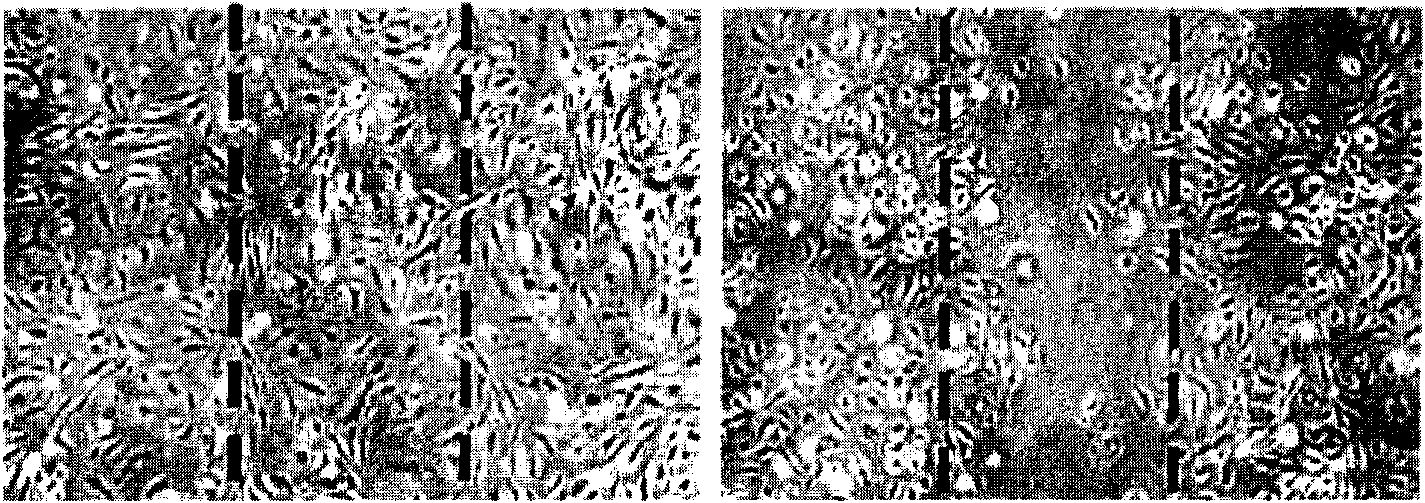Decapeptide inhibiting angiogenesis and use thereof
A technology of angiogenesis and derivatives, applied in the field of biomedicine
- Summary
- Abstract
- Description
- Claims
- Application Information
AI Technical Summary
Problems solved by technology
Method used
Image
Examples
Embodiment 1
[0032] Example 1: Kp-10 inhibits the proliferation of human umbilical vein endothelial cells (HUVEC)
[0033] Purpose and principle: MTS Assay was used in the proliferation experiment of human umbilical vein endothelial cells. The MTS Assay is an assay that uses a colorimetric method to indirectly measure the number of viable cells. CellTiter AQueous single-solution reagents consist of a tetrazole compound (inner salt; MTS) and an electron coupling reagent (thiophenazine, PES). MTS can be produced by dehydrogenase in metabolically active cells to form soluble particles in tissue culture medium. The absorbance value of the product measured at 490nm is directly proportional to the number of living cells in the culture.
[0034]Methods: Human umbilical vein endothelial cells (HUVEC) were added to 96-well plate, and the control group and sample addition group were established. The solvent was added to the control group, and different concentrations of Kp-10 polypeptide were ad...
Embodiment 2
[0036] Example 2: Kp-10 inhibits the migration of human umbilical vein endothelial cells in the scratch test
[0037] Purpose and principle: Under the action of vascular endothelial growth factor (VEGF), human umbilical vein endothelial cells can migrate to the scratch area without cells. By observing the amount of endothelial cells migrating into the scratch area, it was evaluated whether KP-10 has the ability to inhibit the migration of human umbilical vein endothelial cells.
[0038] Method: Human umbilical vein endothelial cells were added to the 6-well plate, and when it was about full, a cross-shaped scratch was made with a Tip, the scratched cells were washed with PBS, and culture media containing different drug concentrations and VEGF were added. 5%CO 2 Cultivate in the incubator at 37°C until the cells on both sides of the streak migrate to the streak area.
[0039] Evaluation of the results: Observing the statistics of photographs under an inverted microscope, the ...
experiment example 3
[0040] Experimental Example 3: Kp-10 Peptide Inhibits Boyden Chamber Migration of Human Umbilical Vein Endothelial Cells
[0041] Purpose and principle: The Boyden migration assay is based on the separation of a Boyden chamber into two parts by a microwell. The cells are placed on the upper part, and the lower part contains chemokines. Under the induction of chemokines, the upper layer of cells can migrate through the microporous membrane to the bottom of the membrane and attach to the back of the membrane. This experiment can detect drugs Effects on the ability of endothelial cells to cross microporous membranes.
[0042] Method: Coat the chamber with gelatin, and discard the gelatin after incubating at 37°C in an incubator. Add cell culture medium containing VEGF to the six-well plate outside the small chamber, insert cells into the small chamber, incubate in the incubator for four hours, suck up all the culture medium, fix the small chamber in paraformaldehyde, and wash th...
PUM
 Login to View More
Login to View More Abstract
Description
Claims
Application Information
 Login to View More
Login to View More - R&D
- Intellectual Property
- Life Sciences
- Materials
- Tech Scout
- Unparalleled Data Quality
- Higher Quality Content
- 60% Fewer Hallucinations
Browse by: Latest US Patents, China's latest patents, Technical Efficacy Thesaurus, Application Domain, Technology Topic, Popular Technical Reports.
© 2025 PatSnap. All rights reserved.Legal|Privacy policy|Modern Slavery Act Transparency Statement|Sitemap|About US| Contact US: help@patsnap.com



